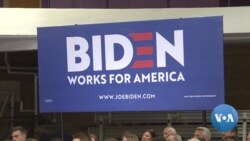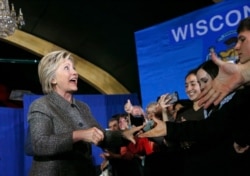As she looks ahead to the 2020 Presidential election, it’s hard to reconcile the past for Egg Harbor, Wisconsin voter Bernadette Rainsford, who believes there is one key reason why Donald Trump won her state in 2016.
“Hillary didn’t get here last time,” Rainsford told VOA. “We thought it might have helped."
It’s a complaint echoed by many Wisconsin Democrats who believe Hillary Clinton could have won the election if she had personally rallied voters here in the final weeks of the campaign.
But polling in Wisconsin, Michigan, and Pennsylvania – three key midwestern states Trump narrowly won - showed Clinton didn’t need to.
“Over 100 polls were done in those three states, and only one in Michigan in October ever showed Trump actually leading,” said Charles Franklin, Director of the Marquette University Law School Poll, which then and now, gauges voter sentiment monthly.
“That cumulative public polling, including mine, was part of the reason that the evidence pointed to a Clinton win here. It was a sweeping error,” he added.
An error in several states in the lead-up to the 2016 presidential vote perhaps, but the numbers matched up nationally.
“Nationally the polling showed Clinton with about a three-point lead in the popular vote,” said Franklin. “She actually won the popular vote by about a 2 percent margin.”
But Donald Trump carried Wisconsin - by fewer than 25,000 votes out of nearly 3 million ballots cast. His narrow victory there helped his overall win in the Electoral College, made up of 538 state-chosen electors who ultimately decide presidential contests.
Franklin said several factors explain why polling in 2016 didn’t accurately predict that outcome.
In Wisconsin, many undecided voters made up their minds in the final weeks of the campaign, when Trump appeared in the state numerous times. Meanwhile, Hillary Clinton campaigned elsewhere.
“Of people who said they decided in the last week, two-thirds voted for Trump and one-third for Clinton in the Wisconsin exit poll data. And for people who were conflicted and did not like either candidate, 75% voted for Trump,” he said.
Another factor, said Franklin, was the education levels among those polled.
“In the past, higher education has correlated with voting more Republican, lower education voting more Democratic,” he said. “But in 2016, nationally but especially in these three Midwestern states, that largely shifted with Trump gaining his strongest support especially among whites who do not have a college education."
To avoid a similar problem next year, pollsters are weighting their samples differently to gauge how people with different educational backgrounds are likely to vote, he said.
Wisconsin is considered a key state for both parties to win the White House in 2020. Franklin says pollsters who gathered information about voter sentiment in the weeks leading up to the 2016 election and got it wrong, should adjust to get it right in 2020.
“In our case, we’re going to push voters a little harder who are undecided to say, ‘Well, but if you had to decide right now who would you vote for?’ to capture maybe some of those late breaking decisions, and we can make other decisions about education and so on,” Franklin explained to VOA from his home office in Wisconsin’s capital city, Madison.
“I think for me and every other pollster between now and November 2020 will be a process of evaluating the quality of our data as well as we possibly can, but ultimately making a decision to trust the data rather than trust our own instincts. But in the end, I think we have a professional responsibility to report the best data that we’re capable of creating and then let the chips fall where they may, and that's the position I'll be taking through the coming year.”
Sitting among the crowd at a campaign rally for former Vice President Joe Biden in Dubuque, Iowa – situated on the border of Wisconsin - Bernadette Rainsford hopes the eventual Democratic nominee won’t rely as much on polling this time around. Rainsford said she already notices candidates paying more attention to her state.
“I’m happy that the Democrats are going to be here this time,” he said.
Franklin said current polling in Wisconsin is mixed, with Trump owning a slight lead over his top Democratic challengers, including Biden, in head-to-head matchups in the November 2020 general election. But he also adds a lot can change between now and then.












